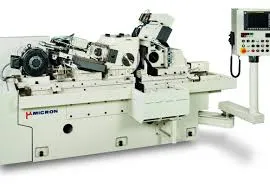What is Centerless Grinding?
Today we are going to answer a simple question about a simple machining process; What is Centerless Grinding?
Centerless grinding is a process that has been a part of manufacturing for nearly 100 years. It helps solve one of the limitations of other types of turning machines such as lathes and mills. The process is better suited to deal with the limitations imposed on lathes and mills with respect to the size, material type, and finishes of different surfaces that may not be as adaptable to other machining processes.
The process is one in which material is removed from components or goods by means of abrasive cutting or grinding. Yes, it really is that simple.
It is different from centered grinding in that there is no spindle used to hold in place the material on which the work is being carried out. Instead, it is secured between a pair of rotary grinding wheels that rotate at pre-set speeds. This determines the speed at which excess material is removed
How Does Centerless Grinding work?
A combination of the cutting pressure and capability of the grinding wheel and the gravity acting on the workpiece ensures that the work maintains contact with the control wheel and the rest blade. The control wheel (or regulating wheel) is normally made from a rubber bonded material that offers a frictional surface that is constantly advancing. This makes sure there is a steady, continual rotation of the work which is at exactly the same surface speed (or peripheral velocity) as the control wheel.
Centerless grinders don’t have a lot of moving parts and instead owe much of their functionality to some basic principles of physics. That makes centerless grinding a relatively simple process that’s ideal for finishing the outside diameter of small cylindrical metal parts requiring a tight tolerance.
As can be seen from the diagram above, there are five main elements in the centreless grinding process:
- An abrasive grinding wheel
- A control or regulating wheel
- A work rest blade
- The workpiece that needs to be ground, which can be a component or piece of material
- Suitable guides that support the work as it enters and exits the wheels or as the grinding takes place
- The workpiece that needs to be ground, which can be a component or piece of material
During grinding, the force of the grinding wheel pushes the workpiece into the regulating wheel which operates at a far slower speed than the grinding wheel, and against the support. This is how the workpiece is held in place, by pressing it between the regulating wheel and the grinding wheel.
The regulating wheel then determines the workpiece’s rotational speed. This controls the actual speed at which grinding takes place.
The regulating wheel is a critical element in the generation of roundness in centreless grinding, as the regulating wheel supports the workpiece and precisely positions it during the grinding. The workpiece circumference should simultaneously be in line, contact with the grinding wheel, work rest blade, and the regulating wheel. This is why it is very important for the regulating wheel to provide grip to ensure that the workpiece is in the correct position.
The arrangement of these elements can be different on different machines, depending on what type of centreless grinding is being enacted, but no matter which model or type of machine, the principles of the process remain the same.
This is a virtually continuous process, because, compared with grinding between centers, the loading time is relatively small. Even extreme long lengths can be ground continuously and large quantities of small parts can be automatically ground by means of various feeder attachments.
In addition, centerless grinders are capable of performing consistently at high speeds. That makes the process a great choice for high-volume applications in aerospace, automotive, military, medical, and other industries.
What are the different methods of centerless grinding?
So now that we have answered the question of what is centerless grinding, we can look at the different types.
The process is distinguished by the method employed to remove material from the workpiece. It can be classified either as the through-feed, or in-feed type of centerless grinding.
Thru-feed grinding
In this process, the workpiece is fed through the center of the two grinding wheels. Thru-feed grinding is best used for parts that are cylindrical in shape. The regulating wheel can be set at such an angle that it pulls the material through the grinding process, without the need for any separate feeding mechanism.
Infeed grinding
Sometimes called plunge grinding, this is used to grind cylindrical parts with notches or complex shapes, such as gear shafts.
Here, the workpiece rest blade needs to be tooled to match the shape of the part. The grinding and regulating wheels must be dressed to match the part’s desired profile cut.
The regulating wheel spins the part at one speed while pushing it towards the grinding wheel, which is spinning at a faster speed. The greater the difference in speeds, the faster the removal rate.
Precision CNC Centerless Grinding Machine 0.8-60mm
How important is the grinding wheel?
Perhaps the most major factor in centerless grinding is the choice of grinding wheel. It must be suited to both the metal from which the parts are made and the surface finish required.
In addition to being available in different diameters and widths/thicknesses, grinding wheels come in different grain types and grit sizes, often using super abrasive materials such as polycrystalline diamond and cubic boron nitride.
These super abrasive (super hard) and silicon carbide wheel materials are an advantage when grinding very hard metals, for several reasons:
- The wheels themselves are durable and maintain their sharpness longer.
- They have high thermal conductivity, maintaining their shape at high contact temperatures and at high rotational speeds.
- Less time is required for the dressing cycle.
- Wheel life is much longer than that of wheels made of materials such as aluminum oxide abrasives.
Which industries use centerless grinding?
A companion question to what is centerless grinding is “which industries use it”? The simplicity and effectiveness of the process mean that it is ideal for use in machining parts for many major industries:
- Aerospace
- Agriculture
- Automotive
- Defense
- Medical
- Military
- Motorsport
- Power generation
- Research and development
- Sub-sea oil and gas
- White goods
Our wide client base means that the millions of parts that we grind every year end up in some quite extraordinary places. Components and bars that we grind could be used anywhere from at the bottom of the sea to way out in space. They could equally find themselves in a nuclear reactor as on a NASCAR winner. We also provide work for hundreds of precision and general engineering and manufacturing companies all across the US.
Is this grinding process only used on workpieces?
The simple answer to this question is No. Precision ground bars are that are further machined using the process to achieve high dimensional tolerances. They are supplied in volume to those clients who require very tight tolerances for their components, such as pneumatic cylinders, valve stems, piston, and pump shafts.
They are a semi-finished product where our clients will not need to further machine the diameter or enhance the surface finish. Our steel bar can be centreless ground to your exact sizes and tolerances, get a quote today.
We hope you enjoyed reading the answer to the question – What is centerless Grinding?.
-
Discount High-Precision Surface Polishing Machine Durable & EfficientNewsApr.29,2025
-
High-Precision SS Square Tube Polishing Machine China SupplierNewsApr.29,2025
-
Stainless Steel Square Pipe Polishing Machine OEM & High-EfficiencyNewsApr.28,2025
-
Centerless Grinder Troubleshooting Fast Fix for OEM, China & Discount ModelsNewsApr.28,2025
-
Centerless Grinder Automation Solutions OEM & Precision Systems ChinaNewsApr.28,2025
-
Scarlo Centerless Grinder OEM High-Precision China Models & DiscountsNewsApr.28,2025



